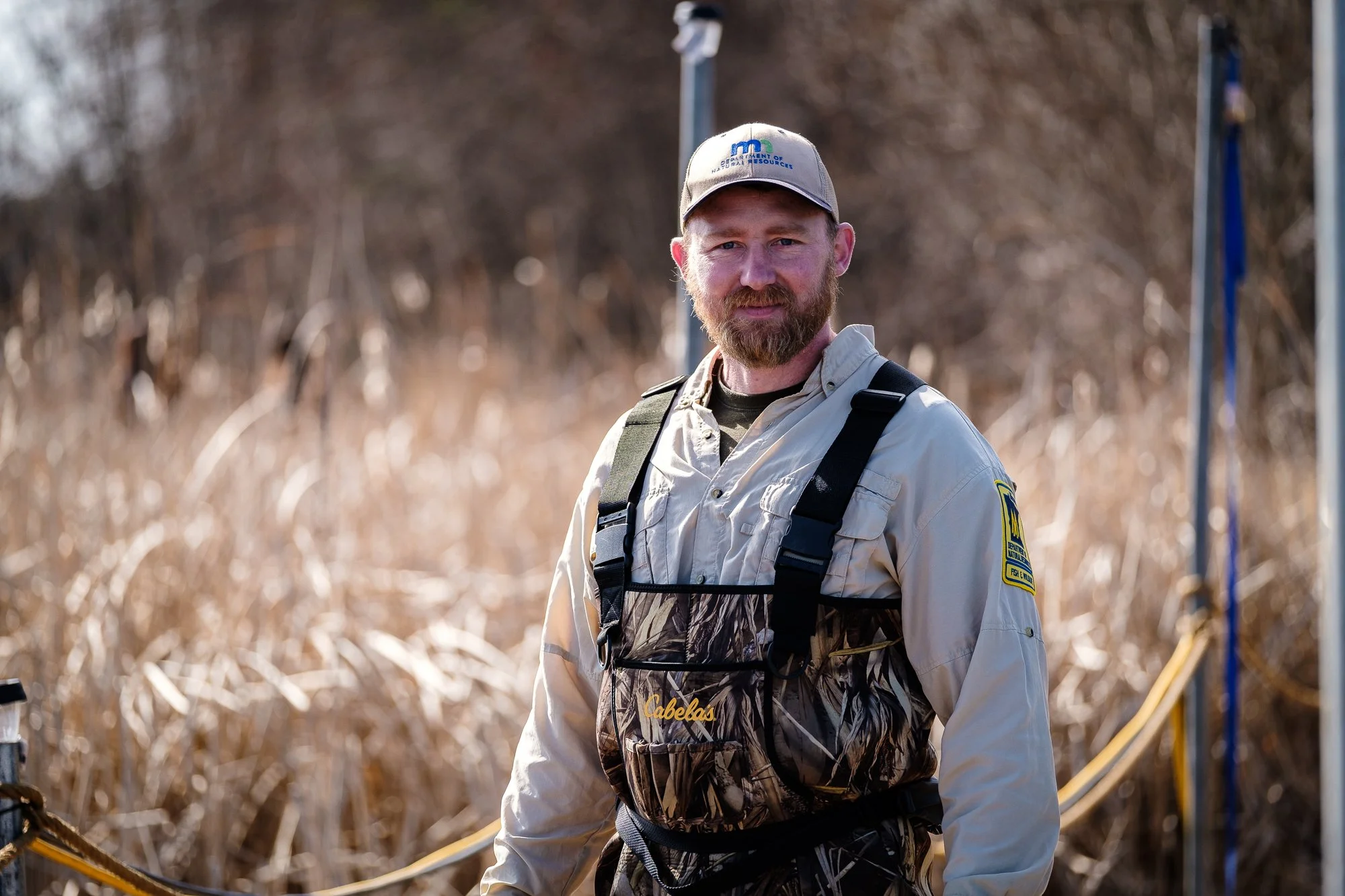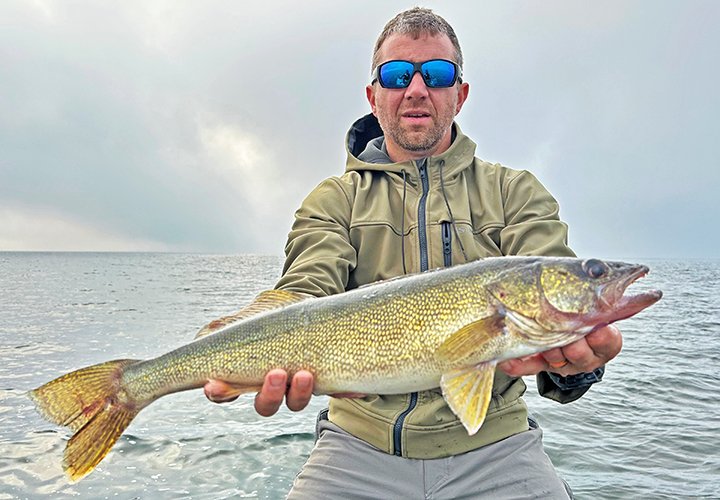Walleye fishing on Lake Winnibigoshish remains good, but timing your trip for early morning and late evening is a very good idea. Daytime fishing can be good if the conditions are favorable for walleye feeding. Overcast skies combined with moderate winds continue to produce good action. When the sun is shining, and the water is calm, the bite slows considerably. Ironically, folks have been catching some of the largest walleyes during periods when the action is slow.
Lake Winnie Walleye, Courtesy Dusty Snyder
Most folks continue to fish over mid-lake structures, particularly smaller free-standing humps. Most of them top out at 16 to 22 feet and are surrounded by water depths of 30 to 35 feet. The most active walleyes tend to gather high on the edges, key depths vary between 16 and 24 feet. Sometimes walleyes move deeper on the breaklines, but there are a lot of fish that move away horizontally and suspend. It has been common to see walleyes suspended at 18 to 20 feet over the 30-to-35-foot soft bottom basin.
The suspended fish have been difficult for most anglers to catch, but there are some pros who manage to coax some of them into striking. Most of them agree that using slip-floats, leeches and small jigs have been the most reliable presentation to use in these situations.
More traditional methods for catching fish on structures are jigs tipped with leeches, live bait rigs tipped with night crawlers and spinners presented using bottom bouncers. There are some anglers also catching fish casting smaller, lightweight jigs tipped with ½ night crawlers and fishing them back to toward the boat using a swim-drop-swim-drop-retrieve. The lighter jigs help keep the lures up above bottom where they are more visible to the fish, and less prone to snagging on clusters of zebra mussels.
The zebra mussels are the key reason why lindy rigs using plain hooks tipped with leeches should be avoided. Lindy Rigging with night crawlers that are injected with some air from a work blower stay above bottom, and seldom get fouled. Leeches don’t swim as well as we think they do, and they frequently touch the bottom, becoming fouled by the zebra mussel clusters. This is one reason for the recent surge in popularity of slip-floats on Lake Winnie, they have gone from a seldom used tactic, to one of the top producing presentations in recent years.
Despite the popularity of fishing mid-lake structures for walleye, there are a handful of anglers finding fish in shallower water. The warm, sunny conditions have brought surface water temperatures back into the high 70-degree range, even hitting 80 degrees in certain protected areas. There’s a fairly robust algae bloom in some regions of the lake, and shoreline breaks related to patches of vegetation are holding some fish.
On the shoreline, trolling with spinners tipped with fathead minnows has become effective. For a mix of walleye, pike and perch, troll the same areas using shallow diving crankbaits. Rattling crankbaits that run at 4 to 6 feet of water are best on the shoreline. Deeper diving crankbaits can be used on the flats too, key depths are 12 to 14 feet, and scattered pods of all 3 predator species are encountered at random intervals.
Cutfoot Sioux Sunfish, courtesy Bob Slager
Another by-product of the warm surface water temperatures is the improved sunfish activity. Some of our guests are finding good eating size sunfish and bluegills trolling the edges of cabbage and coontail patches everywhere in the Cutfoot Sioux chain of lakes. Key depths range from 6 to 10 feet, with 8 feet being a reliable target depth. Once sunfish are found, there are times when stopping the boat and fishing vertically with small jigs may be more efficient, but while the water remains warm, trolling is very effective. Use a single hook spinner with a #3 blade and tip the hook with either night crawlers or medium size leeches.
Alternatives to trolling for panfish are some of the spinner type jigs like beetle spins, road runners and the like. Cast the edges of cabbage flats and retrieve slowly using a drop-swim-drop presentations. Don’t be surprised when an active bass, pike or crappie attacks the spin-jigs as well.
Lake Winnie Northern Pike, courtesy Jake Hamilton
Pike have been more elusive this week than they were last week. The warm, sunny weather has not been favorable for activating them. When caught, there have been some nice sized ones though, and most come as a by-catch while folks are trolling for panfish and walleyes. If all things weather related remain equal, the next full moon should bring about a period of increased pike activity; it typically does.
Crappie anglers report hits and misses right now, with most fish coming at dawn, or late in the evening. It seems that the current populations are low, but there are some nice, 11-to-12-inch fish in the system. For best results, fish early in the morning wherever you find the best patches of healthy cabbage. Small jigs tipped with plastic action tails, cast into gaps and pockets will produce strikes. If you find an area that “looks good” during the day, be sure to try it as the sun goes down in the evening. When they go on the prowl, they will become easier to catch.
Perch, by all accounts have been smaller than usual this summer. There are still some nice ones out there, and our best advice is when stumbling into them at random locations, take advantage of the opportunity. The perch, especially the larger ones, appear to be nomadic, rarely being found in some spots from one day to the next. Again, sunshine and calm seas don’t favor great perch action either, so we could see an uptick in the action whenever the clouds and choppy conditions appear.
We’re at a pivotal time in the season, quietly and without fanfare, fish are adjusting to changes in their food sources. As insect hatches run their course, and young of the year fish become attractive targets, many will return to the shoreline and become minnow-oriented predators once again. Every season, sometime in August, the shallow water action begins to intensify. Where it will be, and exactly when it will happen is tricky to pin down, but it will happen, and we’ll be watching for it. Stay tuned for updates as they become available.






















